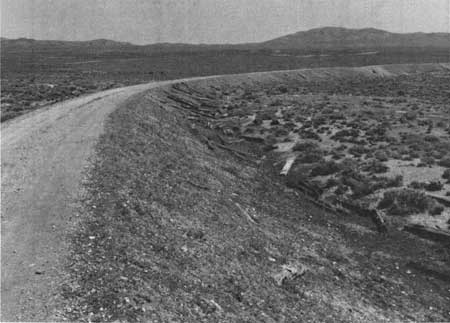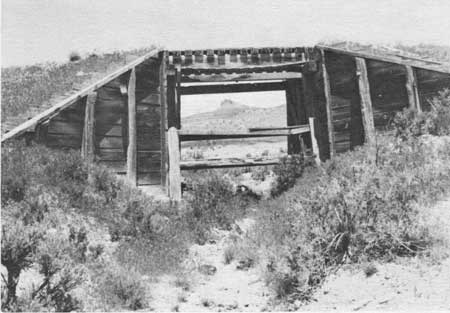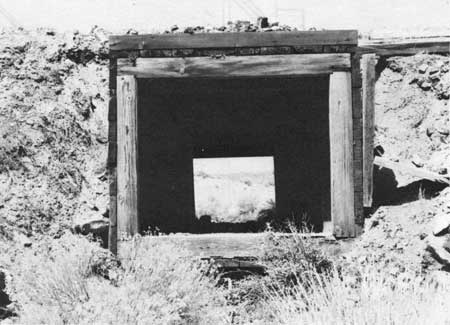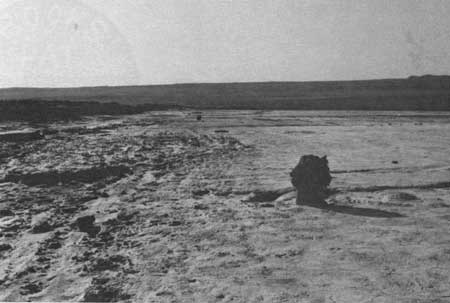Rails East to Promontory
The Utah Stations
|

|
VISUAL FEATURES AND FACILITIES TODAY
Building a railroad leaves scars, now considered
important, integral, and often picturesque aspects of our historic past.
Subject to proper management and protection, the railroad grade and its
associated features will exist for hundreds of years. Much of the grade
remains and serves as a travel corridor across the Great Salt Lake
Desert (Fig. 88, 89). Sidings are often characterized by railroad ties
still embedded in the grade. Large rock cuts in the Peplin and
Promontory Mountains (Fig. 90) and large earthen fills, including one at
Dove Creek (called Duff Creek in railroad documents), testify to the
fortitude and perserverance of the railroad workers (Fig. 91).

|
|
Figure 88: Engineering Design for Special Roadbed in Arid Regions (Courtesy of Southern Pacific)
(click on image for a PDF version)
|

|
|
Figure 89: Railroad grade in the Utah desert today. (BLM photo)
|

|
|
Figure 90: A large rock cut for the railroad grade in the Peplin
Mountains. (BLM photo)
|

|
|
Figure 91: The large earthen fill carries the railroad over
Dover Creek Sink. (BLM photo)
|
Erosion control techniques employed over a century
ago contribute to the grade's longevity. In the Peplin Mountains,
railroad ties are embedded upright in the wash channels upstream from
the grade to divert runoff water through culverts (Fig. 92). Despite
limited precipitation, the soils of the Salt Desert erode easily,
evidenced by numerous gullies and arroyos. Culverts and bridges were
continually rebuilt to keep pace with erosion. Evidence remains for more
than 150 such structures. They are discussed here in order of decreasing
size:
Large washes and deep arroyos required open deck,
piled, trestlework bridges (Figs. 93, 94). A "piled," bridge refers to
upright foundation timbers deeply embedded in the ground. Initially
during the rush to Promontory Summit, many of these bridges were not
"piled," but built on timbered sills. The time-consuming task of piling
the trestles was accomplished later by Chinese section gangs. Also,
flimsy trestles were later filled up and replaced with small culverts by
Chinese section gangs. Figures 95 and 96 illustrate late 19th century
Southern Pacific "Common Standards" for trestlework bridges. Riprap
(rocks, boulders, used boiler bricks and other trash) was deposited in
the washes to reduce under cutting of the piles.

|
|
Figure 92: Railroad ties embeded in a wash channel to divert
erosion away from the railroad grade. (BLM photo)
|

|
|
Figure 93: Trestle-work bridge over Rosebud Creek. (BLM photo)
|

|
|
Figure 94: Single stringer trestle with large wing-walls. (BLM photo)
|

|
|
Figure 95: (Rendered from Southern Pacific Common Standards 1896,
courtesy of Southern Pacific) (click on image for a PDF version)
|

|
|
Figure 96: (Rendered from Southern Pacific Common Standards 1896,
courtesy of Southern Pacific) (click on image for a PDF version)
|
Smaller drainages and gullies required wood box
culverts (Figs. 97, 98, and 100), often constructed of California
redwood (Fig. 99). There is a limited occurrence of redwood stave
culverts, implying an early design and subsequent phase-out. Wooden
stave culverts are aesthetically interesting variations of the wood
culverts (Fig. 101).

|
|
Figure 97: Wooden box culvert - about 3 feet square. (BLM photo)
|

|
|
Figure 98: Wood box culvert with wing-walls, apron and riprap. (BLM photo)
|

|
|
Figure 99: (Rendered from Southern Pacific Common Standards 1896,
Courtesy of Southern Pacific). (click on image for a PDF version)
|

|
|
Figure 100: Dual wood box culvert. (BLM photo)
|

|
|
Figure 101: Wooden stave culvert with wing-walls, apron, and
riprap. (BLM photo)
|
Stone culverts are the most numerous. Two varieties
occur: (1) stone box (Fig. 102), and (2) open deck (Fig. 103). Riprap
was used to reduce erosion. Some of the stone culverts were widened with
wood box extensions when the track gauge was widened.

|
|
Figure 102: Stone box culvert. (BLM photo)
|

|
|
Figure 103: Open-deck stone culvert. (BLM photo)
|
Other features include rail-rests for storage of
replacement rails (Fig. 104) and remnants of the telegraph. The 1862
Pacific Railroad Act called for construction of a telegraph line to
parallel the right-of-way. Prior to the coming of the railroad, the
primary east-west transportation and telegraph route crossed central
Utah, south of the Great Salt Lake. Both the telegraph and Overland Mail
service moved north to accompany the railroad in 1869 (Fike and
Headley 1979:57).

|
|
Figure 104: Rail rests near Ombey. (BLM photo)
|
The original telegraph line was built on the south
side of the track. Stumps of the square poles
(Fig. 105) and pieces of the late cross arms (Fig.
106) are visible today. Figures 107-110
illustrate the insulators use. Other telegraph lines
were built and located along the grade
(Fig. 111). Figure 112 is a cross arm which housed
the early "ramshorn" insulators.

|
|
Figure 105: Stumps of telegraph poles near Kosmo. (BLM photo)
|

|
|
Figure 106: Telegraph cross arm for predominately Hemingrey
Insulator 42. (BLM photo)
|

|
|
Figure 107: Goodyear Patent Insulator 1861.
|

|
|
Figure 108: Brooks Patent Insulator, Patent 1867, used until about 1880.
|

|
|
Figure 109: Insulators: Electrical Construction and Manufacturing
Company, San Francisco (made before 1880) and Brookfield Company, New York.
|

|
|
Figure 110: Brookfield Insulator and pole peg.
|

|
|
Figure 111: Stump from early telegraph pole near Lake Station. (BLM photo)
|

|
|
Figure 112. Cross arm from 1869 telegraph pole. Note - sockets from
"Ramshorn" insulators. (BLM photo)
|
ut/8/sec3.htm
Last Updated: 18-Jan-2008
|

























